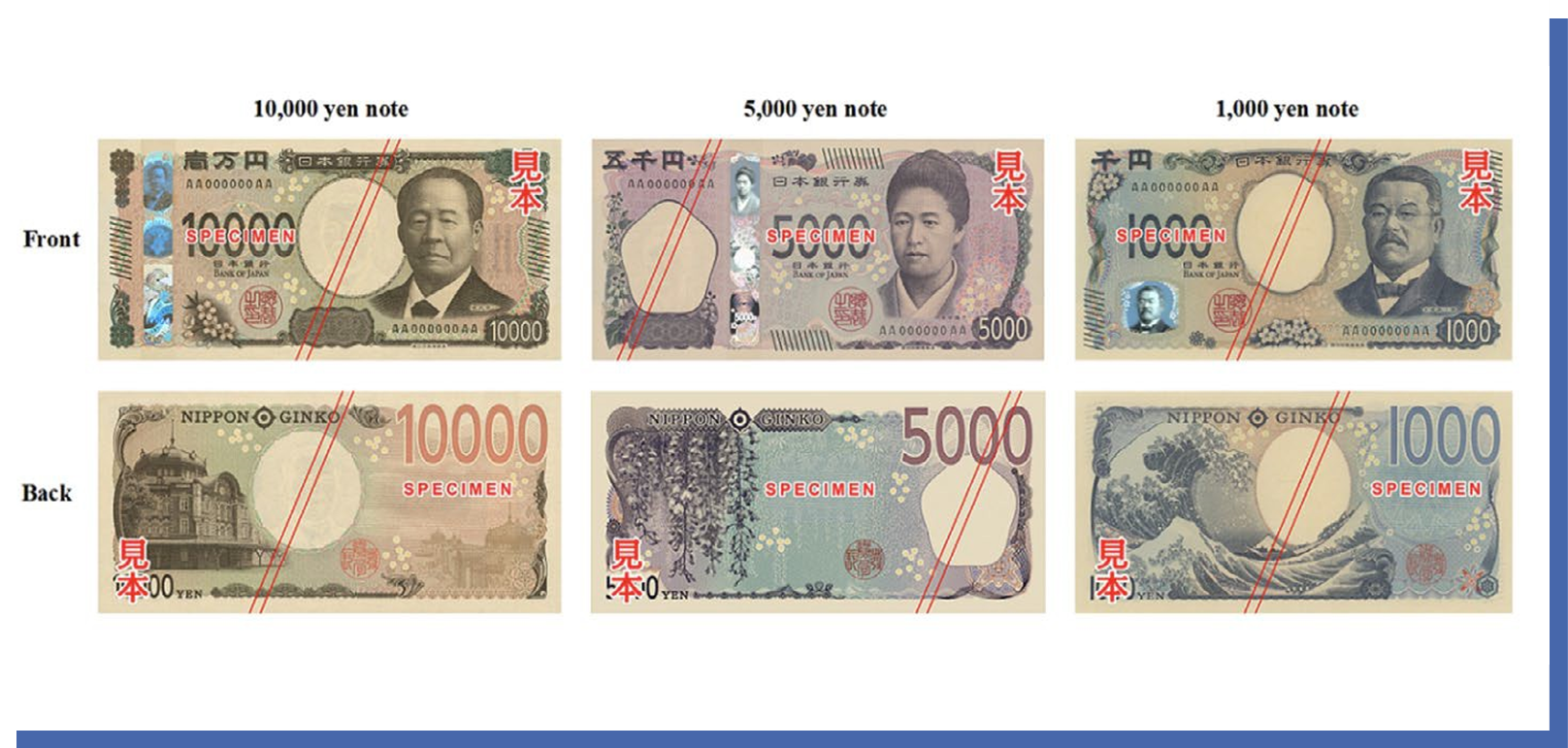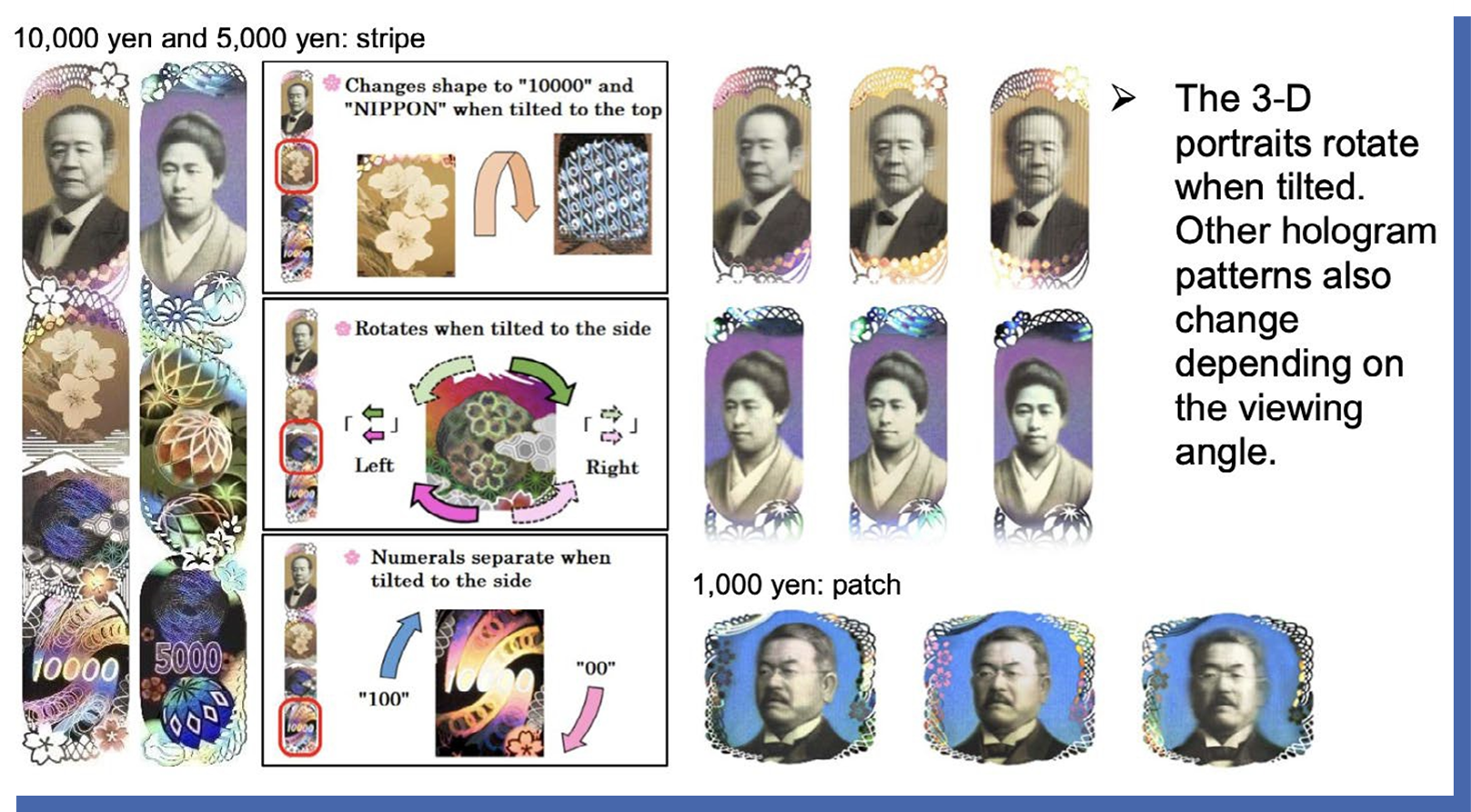



On 3 July 2024, the Bank of Japan (BoJ) issued a new series of banknotes carrying holographic portraits. In the first design change in 20 years, the 10,000, 5,000, and 1,000 yen bills contain what appears to be a different stereographic portrait.

Each denomination has a similar design format, with enlarged numbers of the face value, improved tactile marks, a central portrait on the front, and an emblematic Japanese design on the reverse. (Ed: the series was first covered in the May 2023 issue of Holography News®, which is when the BoJ first unveiled the new designs).
The 10,000 yen displays Eiichi Shibusawa, known as the father of Japan’s capitalism. The main colour of the note is brown and the design on the reverse is of the Tokyo Station Marunouchi Building. The holographic portrait, which mirrors the printed portrait, is contained within a stripe.
On the 5,000 yen bill is a portrait of Umeko Tsuda, a pioneer in women’s education who founded Tsuda University in Tokyo. The main colour of the note is purple and the design concept is based around Japanese wisteria flowers. As with the 10,000 yen, the holographic portrait is part of a larger holographic stripe.
The 1,000 yen banknote features Shibasaburo Kitasato, a pioneer in serotherapy treatment of infectious diseases, on the front. The main colour of the note is blue, with the design of ‘Kanagawa-oki nami ura’ (Under the Great Wave off Kanagawa) from the series Fugaku sanjūrokkei (Thirty-Six Views of Mount Fuji), a Japanese ukiyo-e woodblock print by Katsushika Hokusai, on the reverse. In this note, the holographic portrait is applied as a patch.
In addition to the holographic portraits, other security features include high- resolution watermarks, latent images and iridescent inks.

Educational material from the BoJ claims that this is ‘the first time that a 3D hologram has been used on a banknote’. The description of the holograms is more judicious on the public awareness campaign poster, which states that this is the first use of ‘3D portraits on banknotes’.
Whatever the description, the holographic portraits are exceptionally life-like – resembling photographs in their realism, but with the added advantage of movement. They represent an important authentication element, encouraging the public to tilt and rotate the notes to witness the changes in the perspective of the portraits and colour patterns in the surrounding graphics.
The BoJ has been stockpiling the notes since 2022, when the National Printing Bureau, Japan’s state printworks, started mass production. The total stockpiled had reached 4.53 billion notes at the end of fiscal 2023. According to the government, nearly 7.5 billion new banknotes will have been printed by the end of March of next year.
Most transactions in Japan are still done in cash, and cashless payments have been slower to catch on than in many other countries. Although the world is moving toward cashless interactions, BoJ Governor Kazuo Ueda said cash remains essential to settle payments anywhere and anytime safely.
Meanwhile, Prime Minister Fumio Kishida praised the state-of-the-art anticounterfeit traits of the new bills as historic. He told reporters that he hopes the people will like the new bills and that they will help energise the Japanese economy.
The new notes will not only benefit the Japanese economy, but the Nepalese economy as well.
Japanese banknotes have historically been made from mitsumata (or the Oriental paperbush) which has particularly fine fibres, abaca pulp and other fibres, giving the paper a unique colouring and texture, and enabling the exceptionally detailed and high quality watermarks for which the country’s currency is renowned.
Japan began using mitsumata for its banknotes in the late 19th century, but domestic production dwindled, partly due to the ageing of Japan’s population. Today, most of the material is imported, albeit some prefectures in Japan are working to keep the tradition alive.
Nepal began exporting the paper bush to Japan over a decade ago, and it has already replaced mitsumata,. While Japanese paper is considered the best in the world, Nepali paper is considered stronger and better quality than most paper abroad, leading to high demand.